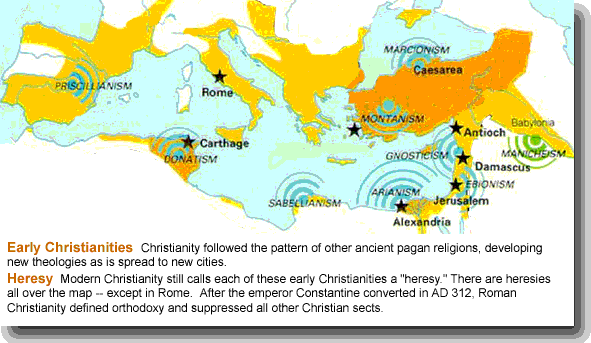 |
 |
|
After Christ The Myth |
After Christ Scholarship |

The Triumph of Christianity >> Triumph
|
The first
schism St. Paul, from the Hellenized city Tarsus, saw it different. You became Christian, you didn't get circumcised (whew!), you didn't have to follow Jewish ritual -- you didn't convert to Judaism. The two sides argued. You read the New Testament, you get the feeling Paul and his pals won. That's because the New Testament is partly a product of the first Christian schism, written before the convert / don't convert question was finally settled, including gentile- permissiveness as a theme, spinning Paul's point of view. What you miss, reading Acts, is that the gentiles-convert sect did not convert to Paul's brand of Christianity. They formed their own Christianity. They became (probably, details are fuzzy) the Ebionites. They followed Christ, but insisted initiates also convert to Judaism. They had their own New Testament, now lost in the bonfires of suppression. The later Church fathers, Tertullian, Origen, Hippolytus, describe the Ebionite "heresy" lasting well into the third century AD. (By the way, you'll
probably be interested to hear the Ebionites denied the divinity of
Jesus and his virgin birth -- presumably those legends got tacked
on to the Christ myth after the first
schism.) |
A zoology of Christianities |
 |
|
In the decades and centuries that followed the first schism, Christianity continued in the pattern of the ancients' other Pagan religions. The Pagan habit of doctrinal freedom led Christ's believers to develop dozens of different Christianities. Here's a partial list: | |
|
|
|
Other things weren't new, and people didn't argue about them. What the early Christians didn't split into new sects over were baptism, the Eucharist, the soul, eternal life, salvation, etc. -- exactly the things they inherited from the other ancient Pagan religions. Everyone knew how they worked. Why argue? Different Bibles. We think the
And so on. There were dozens of Gospels, dozens of Epistles, dozens of Acts. How Basically our New Testament was put together late in the fourth century, with books picked by Roman Catholic clergy. They set the number of Gospels at four because that's the number of winds. [I am not making this up.] By the way, have you maybe
noticed the "Jewish" Old Testament isn't the book modern Jews use?
That's because the books of Christian Old Testament were also picked
not by Jews but by orthodox Roman Catholic clergy. Who'd
'a thunk it? |
|
Constantine and social Darwinism "Who does not see how much the worship of the name of
Christ has increased." [St. Augustine,
Civ dei :18:45] How'd the conversion happen? Partly by giving Christians preference for government contracts and advancement. Also by coercion. Constantine made divination in public matters was punishable by burning to death. Pagan sacrifices were banned [341 AD]. Nocturnal pagan worship was forbidden [353 AD]. By mid-century, pagan temples were ordered closed. In 356 AD worship of non-Christian images became a capital crime. In 385 Christians tore
the great and famous temple at Edessa to the ground, and the praetorian
prefect Cynegius' trip to Egypt was marked by Christians rampaging
around the pagan cities of Syria as vandalizing, looting mobs.
Taking Pagan gold, but not stealing it, for, "...there is no such thing
as 'robbery' for those In 399 AD Gaudentius and Jovinus, counts of the emperor, "overthrew the temples and broke the images of the false gods" in Carthage. Ever since, says St. Augustine, "Who does not see how much the worship of the name of Christ has increased." [St. Augustine, Civ dei 18:45] Well, no kidding.
|
|
Picking
sides. In 317 Constantine's Roman Christian sectarians in Carthage filled the well outside the main Donatist [non-Roman Christian] church with the bodies of their Christian opponents. In 333 AD Constantine issued edicts against "Arius, wicked and impious," forbidding his teaching and even outlawing just owning his version of the New Testament. "Whoever hides them [Arian's writings] shall be condemned to death." Constantine didn't kid around about stuff like that. At least you knew where you stood. In 382, in Egypt, celebrating Easter on the day set aside by the local non-Roman Christian sect was punishable by death. In 383, in Spain, Urbanica was stoned to death and her bishop Priscillian was executed for their non-Roman Christian beliefs. St. Augustine describes the sectarian struggles in North Africa, in which believers had their eyes torn out and one bishop had his hands and tongue cut off. [Augustine, Epistles 44.7] |
I'm still working on this page.